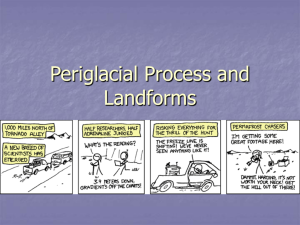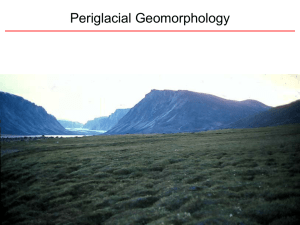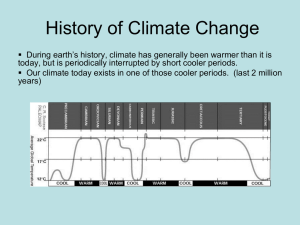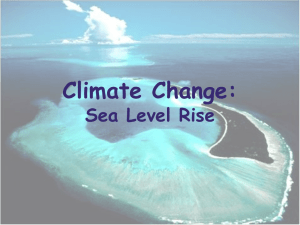Periglaciation - Abingdon School Study Site
advertisement
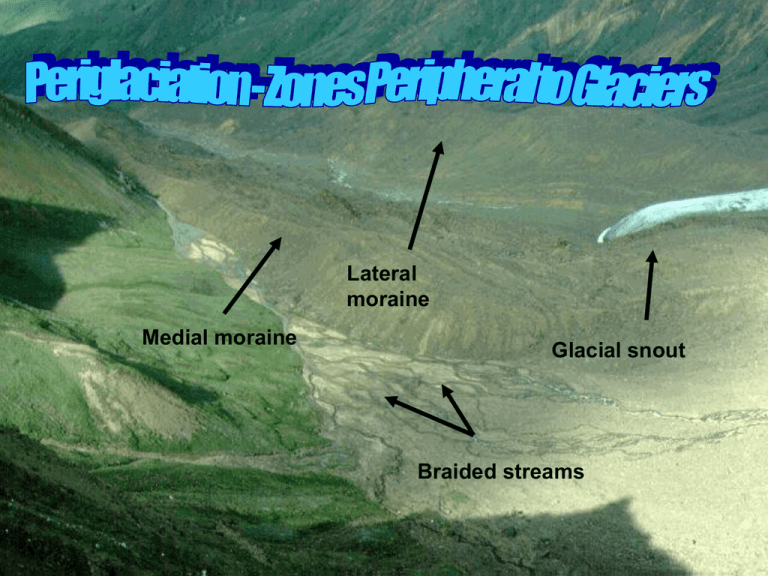
Lateral moraine Medial moraine Glacial snout Braided streams Photo 2: •= Ice wedges polygons + thermokarst lakes Photo 3: •Collapsed Pingo – closed system Photo 4: •Patterned Ground – Stone Circles Some useful links in Periglaciation: http://www.fettes.com/Cairngorms/periglacial_Holocene.htm http://www.mapcruzin.com/arctic_refuge/permcycl.html Where are Peri-glacial Enviornments? •High Latitudes areas - eg Alaska •“Tundra” Regions •High altitude temperate latitudes - eg Alps / Andes •Covers approx. 20% of earth’s land surface •They are the areas found close to (peripheral) glaciers Permafrost The thermal condition of the soil and rock. Temperatures below 0ºC persist over at least 2 consecutive winters and the intervening summer - I.e the ground is frozen PERMAFROST Permafrost •Covers 20-25% of Earth’s surface - eg: •Siberia •Northern Canada •Alaska •China Types of Permafrost: •Continuous •Discontinuous •Sporadic (isolated) •Thickness ranges from several metres > 500m (eg Siberia) Periglacial Processes: 1. Frost Shattering Frost Shattering Frost Heave: a) Frost Pull, b) Frost Push Frost Cracking 2. Weathering Freeze-Thaw Salt-Weathering Carbonation 3. Mass Movements Frost Creep Solifluction – ground NOT frozen Gelifluction – where ground is frozen 1.Frost Action Processes: Dominant set of processes in periglacial environments is freeze-thaw cycles. This operates Most effectively where the temperature oscillates around the freezing point. Frost Wedging • Sometimes called “frost-shattering” • Mechanical (physical processes) caused by the expansion of water in cracks of rock (9%) Frost Creep • Very slow mass movement – through freezing = heaving upwards perpendicular to the slope and then thawing = clasts sink down vertically due to gravity Frost Heave •Frost Pull = occurs when a stone adheres to ice within a freezing active layer and is drawn upwards as the ground heaves •Frost Push / Heave = since stones have a lower specific heat capacity, they heat up and cool down faster than the surrounding soil (a bit like continents heat up and cool down quicker than oceans). A descending freezing front will therefore move through a stone more quickly than it will move through the soil on either side. This means that the soil immediately beneath a stone is likely to freeze and expand pushing the stone upwards – more quickly than the surrounding material = leading to sorting •Involves the displacement of soil and rock underground upwards towards the surface •Produces hills – called pingos and mounds called palsas or thufurs as a core of ice heaves towards the surface All processes work using water. Type is affected by climate and rate by geology. Processes in the hydrosphere Chemical Biological Physical / Mechanical By Freeze-Thaw Action This process usually happens in cold, wet areas. Water enters joints / cracks in rocks and freezes. As water freezes it expands, putting pressure on the joint / crack. The water then thaws as the temperature rises above 0°C, releasing the joint / crack. When the temperature drops again, the water refreezes and so on, eventually the rock breaks off from the pressure. Rock structure (joints): • Frost shattering • Most active where temperature fluctuate around the freezing point • Water expands by 9% on freezing cracking the rocks apart • EG DARTMOOR GRANITE • Salt crystal growth: • Growth of salt crystals – eg sodium carbonate in cracks in rocks – eg saline water gets into cracks or rocks and breaks them down • Common in coastal areas Carbonation: •CO2 is more soluble at lower temperatures – this can increase the rate of solubility of limestone (CACO3 – calcium carbonate). •So in periglacial areas – if there is limestone rocks – that rate of weathering is often much greater •Also if CO2 can be sucked out the atmosphere it is going to get rid of a greenhouse gas The importance of FROST ACTION PROCESSES: The dominant set of processes found in periglacial areas is frost action - eg FREEZETHAW. When water freezes it expands by 9% and can HEAVE the ground - or expand and lift the ground upwards. Because periglacial environments are cold by nature - there is a great deal of frost action occuring there Periglacial Processes cont. 4. Nivation 5. Fluvial 6. Aeolian (wind) Periglacial Case Study Examples: •Alaska •Spitsbergen •Northern Canada •Northern Norway / Lapland •Iceland Solifluction Definition: Mass movement of soil and regolith affected by alternate freezing and thawing. Characteristic of saturated soils in high latitudes, both within and beyond the permafrost zone. A number of features of the Cairngorm environment contribute to active solifluction: •frequent freeze-thaw cycles •saturated soils and regolith, after snow melt and heavy rainfall •frost-susceptible materials, with significant contents of silt and clay, at least at depth •extensive regolith across a range of slope angles Solifluction adds detail to the terrain underfoot. Small-scale, active landforms include lobes and sheets (Sugden, 1971) and turf-banked terraces. The latter reflect also the action of wind in stripping and shaping the vegetation mat and frequently occur in association with deflation surface (Gordon, 1993). Ongoing mass movement is also indicated by 'ploughing boulders' - large blocks that are moving downslope, pushing a rampart ahead of them and leaving a furrow behind. Much more striking, however, are the large boulder terraces and lobes that give crenulated patterns to many granite slopes on the plateau. These steps terminate in stone banks up to 3 m high. These forms are absent from within the limits of Loch Lomond Readvance glaciers (Sisson, 1979) and so date from this or earlier periods. As delicate features such as tors have survived beneath ice covers, it is possible that the larger solifluction terraces and lobes may be of considerable age. Wind The Cairngorms experience some of the highest wind speeds of the British Isles. Gusts over 100 mph may occur several times a year and the weather station recorded the highest UK wind speed in a gust of 173 mph in March 1986. Erosion by strong winds creates deflation surfaces. The vegetation, soil and fine material debris is removed to leave an armoured surface where large clasts are embedded within a matrix of grit and sand. Remnants of the former vegetation cover sometimes occur and allow the former thickness of the regolith to be estimated. Grains of sand and fine gravel can be observed in motion during strong winds. The resting places of the transported debris are often unclear but small sand sheets do occur on the northern flank of Ben Macdui. Deflation scars are bare patches that result from opening up of the vegetation. Wind stripes are lines of vegetation that alternate with bare ground (Bayfield, 1984). Wind crescents are arcuate patches of vegetated ground. Ice patches on the snow result in localised weathering and erosion by freeze thaw. This can lead to small depressions. Saturated material may also slump under gravity - forming a pro talus rampart. Snow forms ice curtains which are prone to avalanches The wet, deep snow on steep valley sides in the summer can hit the valley floor with such force that large areas can be excavated leaving a deep plunge pool Frozen sediments can be removed by riverbank erosion (abrasion, hydraulic action) Fluvial •Frozen sediments are powerful erosive tools. •Sandhurs show enormous changes in discharge throughout the year – obviously a higher rate in summer and spring •Much of the year the ground is frozen so there is little runoff – however in summer when there is more melting there will be more fluvial erosion Periglacial Landforms: Blockfields Rock Glaciers Solifluction lobes Asymmetric Valleys Flattened Summits Pingos Loess Dry Valleys Tors Palsas (frost push on peat) Scree / Talus Gelifluction Lobes/benches Nivation Hollows Pro talus rampart Soil (stone) stripes Thermokarst (Lakes) Sandhurs Coombe Rock Ice Wedge Polygons Involutions Patterned Ground > 5 types 1.Circles 2.Nets 3.Polygons 4. Steps 5. Stripes Earth Hummocks (no sorting) Protalus Rampart Definition: Unsorted, non-stratified, coarse angular rock debris forming arcuate low ridges. Associated with former persistent snowbanks in shaded sites, commonly at base of corrie headwalls. 'Protalus rampart' is an overblown title for a simple landform. It requires the existence of long-lived snow banks below rock cliffs. Frost weathering leads to rockfall from the cliff and the blocks roll down the snow slope to accumulate at its base. Ballantyne and Kirkbride (1986) describe good examples from below the Devil's Point and Sròn na Lairige. These snow patches accelerate freeze thaw (although some studies claim they prevent it!). Under the correct conditions they can develop into full scale glacier cirques. NIVATION HOLLOW PROTALUS RAMPART PALSAS – A PINGO ON PEAT! INVOLUTIONS As water freezes it expands by 9% - repeated freezing and thawing of the active layer causes expansion and contraction of the surrounding material beneath the soil. The resultant breaking, churning, and mixing of the soil, rock and sediment is known as CRYOBURBATION. This can alter beds of sediment that were originally laid down horizontally by twisting and contorting them into folded formations called INVOLUTIONS. Thought to have been exposed by gelifluction removing the surface regolith and subsequently weathered by freeze thaw Note the surrounding felsenmeer Coarse angular blocks on high summits are a typical consequence of freeze thaw weathering BLOCKFIELDS A common feature of periglacial landscapes although not unique to them Where a large quantity of frost-shattered rock becomes mixed with ice, a rock glacier is formed. This can occur either by: 1. A large supply of rock debris being added to a small and thin glacier = ice cored rock glacier. 2. The growth of ice within a large accumulation of rock fragments = ice-cemented rock glacier. They tend to have a steep front, sometimes as much as 100m in height, and they can reach a length of 1km or more. The presence of ice between rock fragments allows the rock glacier to deform under its weight and move downslope at rates of up to 1m per year. Definition: a glacier whose motion and behaviour is characterized by a large amount of embedded or overlying rock material A rock glacier may be composed of: 1. Ice-cemented rock formed in talus that is subject to permafrost. 2. Ice-cemented rock debris formed from avalanching snow and rock. 3. Rock debris that has a core of ice; either a debris-covered glacier or a remnant end moraine. These are a consequence of intermittent freezing of interstitial water allowing the erosion by surface water flow. This process is further increased by gelifluction on the valley sides during periods of partial melting. How have they formed? The melting of segregated and interstitial ice within the soil above the permafrost table results in an excess of moisture. This adds weight, lubricates the particles and moves the material down-slope. Resistance at the front of the mass causes the characteristic lobe to form. These are typically found on gentler slopes with their long axis parallel to the slope contour Tend to form on slopes of angles between 10-20 degrees In valleys experiencing periglacial conditions gelifluction sheets of material derived from surrounding slopes can build up to depths of several metres, and the geliflucted deposit is referred to as HEAD DEPOSIT. It usually contains a mixture of fines, sand and frost shattered stones that have long axes oriented downslope relecting flow direction. – eg chalk downs of Southern England. Sometimes also referred to as COOMBE ROCK. NORTH FACING In arctic regions north facing slopes tend to be frozen all year round whereas the south facing slopes are more prone to freeze thaw and solifluction / gelifluction - which removes material over time by weathering and erosion. Hence the south facing slope tends to be less steep. Nb South facing slopes receive more sunlight SOUTH FACING Nivation hollows, gelifluction and deposition of sediment are all ideas put forward for the creation of these features, which may simply be a glacial remnant SANDHUR Ventifacts > effects of aeolian processes (or wind erosion). It is thought that powerful wind systems blew off glaciers – so wind action was therefore significant in periglacial areas to carve out rocks such as the one here. Lots of finer particles were also taken by wind and deposited 100s miles away = LOESS. Ice Wedges, Polygons, and Pingos As the arctic soil freezes and thaws over many hundred years, it is cracked and buckled to create ice wedges, polygons, thermocarst lakes, and pingos. This next fewpage includes: Steps of the cycle Animation of the cycle Steps of the cycle: There are a number of ways that polygons, arctic lakes, and pingos form. Here's one way this cycle works: A cut-away view of the tundra in summer. The active layer is thawed. Winter cold causes the soil to shrink, and cracks to form. The active layer is frozen, so it acts just like the permafrost soils beneath it. During warm spring days, water seeps into the cracks. It freezes and expands when it is chilled by the still-frozen soil. The frozen water forms wedges of ice in the soil. In summer, the active layer and the tops of the ice wedges melt. Each winter, cracks form again in the same places... and each spring, additional water enters and enlarges the ice wedges as the freezing water expands. This cycle of crack, melt, and freeze continues to enlarge the wedges year by year... until the soil above the wedges is pushed up, forming ridges. If you look down from above, these ridges create a blocky pattern on the ground, called polygons. If the ice is exposed, a wedge may begin to melt. You can clearly see the ice which has cleaved apart the soil in this exposed profile. As more ice is exposed, the ice wedge and the active layer melt lower... until a pond begins to form. The pond water holds heat from the summer sun, so the active layer melts deeper beneath the water. Seen from above, these lakes (called thermocarst lakes) can become longer in one direction when prevailing winds blow waves against the downwind shore. The soil buckles and cracks above the ice wedges, causing these polygons to form . Thermokarst lake. Such THERMOKARST topography is often initiated by the removal of vegetation by man or fire. This allows the surface to be exposed to the full variation of seasonal temperature variations, especially in continental areas. The sun’s radiation (especially in spring and summer) thaws out the ice wedges and active layer in the ground forming these lakes. Is a general term referring to topographyic depressions due to the thawing of ground ice. It is characterised by extensive areas of irregular, hummocky ground interspersed with waterlogged hollows. Large lakes are called alases A closer view of arctic polygons. These are about 70 feet (20 meters) across, although polygons may be as small as 10 feet (about 3 meters) across. Ice wedges Intense cooling and contraction of the permafrost in winter may cause polygonal patterns of cracks to form. In summer the cracks fill with meltwater and some loose material and, upon refreezing the following winter, the crack will be enlarged. Such ice wedges may extend to a depth of 3m and reach 1m in width at their surface. Ice wedge polygons differ from those formed by frost heave in that they are larger (30m diameter) (compared with 1-5m) and their edges are slightly higher than their centres (the edge of the ice deforms the adjacent sediments), whereas frost heave polygons are domed. The larger polygons are found where the winter temperature is below –20C. Ice wedges which are 1-2m wide and 8-10m deep can take up to 100 years to form. The rims on an ice wedge are formed when expansion of sediment during autumn freezing causes material to be pushed upwards as it is forced against the more resistant ice wedge. If the ice wedges melt, they become filled with sediment to form ICE WEDGE CASTS – eg East Anglia Frost Cracking •Water seeps into cracks in the active layer (the surface of the ground / soil which thaws in the summer) up to a metre or more downwards. •This water freezes and then cracks •It cracks because ice has less tensile strength than permamently frozen ground around and below it •The repeated cracking in summers then winters – together with the addition of new ice the following autumn leads to the creation of ICE WEDGES (imagine an icicle underground) or SEGREGATED ICE •Ice wedges (sometimes called ICE WEDGE POLYGONS) are preserved until the climate changes (eg gets warmer) and are replaced by ICE WEDGE CASTS = fine sediments washed and blown into the cracks in the ground The lake side may break down, causing the lake to drain or it could fill up with sediment. Without its insulating cover of water, the active layer begins to refreeze. In winter, the surface freezes over a thawed remnant of the active layer. The very wet soil continues to freeze within the permafrost layer, even in summer. As the unfrozen area continues to contract, the unfrozen water is squeezed under great pressure. Eventually, the water is under such pressure that it pushes upward (the direction of least resistance)... until the unfrozen water collects under the root mat, and freezes, creating a pingo. Closed system pingo If the root mat cracks open enough to expose the ice, the pingo top begins to melt. Water collects in the soil and freezes to form segregated ice. This is less dense than the surrounding material and rises to the surface, creating these spectacular features which can be 10’s of metres high and 1km in diameter Open System: Develop where a body of segregated ice is enlarged by groundwater flow. Instead of forming from trapped groundwater surrounded by permafrost, the open system model involves groundwater under artesian pressure moving through the permafrost to continually feed a centre of expanding ice that domes up overlying sediment. Often found in discontinuous zone of permafrost where groundwater is able to circulate more easily through the sub surface and rock Closed System: Water collects in the soil and freezes to form segregated ice. This is less dense Usually form from the isolation progressive infill and than theand surrounding material and rises to disappearance of a small thelake. surface, creating these spectacular Refer to animation features which can be 10’s of metres high and 1km in diameter As the ice core continues to melt, the pingo collapses further. Continued melting over many years removes most traces of the pingo. When the soil on a pingo cracks open, and the ice core is exposed, the pingo begins to melt and break up. If conditions are right, the cycle will begin again. Much controversy exists over the formation of patterned ground. 1. Some authors feel it is the result of segregated ice bulging the central turf, causing surface material to roll to the edges. Soil may crack under the huge temperature variations in many periglacial environments. The process may be increased by the presence of ice wedges forming in these cracks. 2. It is also hypothesised that ice lenses form underneath the stones which have a greater thermal conductivity (they get cold faster) and these push the stones to the surface. Patterned Ground Patterned Ground > 5 types 1.Circles 2.Nets 3.Polygons 4. Steps 5. Stripes Patterned Ground can be further classified by whether or not it exhibits particle size sorting. Sorted patterned ground – is characterized by the separation of stones (pebbles and boulders) from finer material on the surface so that the stones are organized into circles, nets, polygons, steps or stripes. Frost heave is a key process in the creation of sorted patterned ground as it separates stones from finer material. •Frost Push and Frost Pull = a key process in patterned ground formation Since stones have a lower specific heat capacity than finer sediments, they heat up and cool down faster than the surrounding soil (a bit like continents heat up and cool down quicker than oceans). A descending freezing front will therefore move through a stone more quickly than it will move through the soil on either side. Frost Push As the freezing front will also penetrate beneath a stone relatively quickly – finer material underlying the stone will expand pushing the stone upwards. Frost Pull The top of the stones become frozen as the freezing plane (front) moves downwards through the soil, which pulls the stone upwards with it as it expands.These processes lead to sorting of the clasts (stones) = patterned ground. PATTERNED GROUND Definition: An array of small-scale, geometric features found at the surface of a regolith that has been disturbed by frost action. The group includes circles, polygons, and nets, which normally occur on level or gently sloping surfaces, and steps and stripes which are found on steeper gradients. Both sorted and non-sorted varieties are recognized. The sorted varieties are typically outlined by coarse, stony material, and so are termed 'stone circles', 'stone polygons', 'stone nets', 'stone steps', and 'stone stripes'. The origin of patterned ground involves a complex interaction of several geomorphological processes, including frost sorting, frost heaving, and mass movement. The edge of the polygons mark the position of the ice wedges During the spring when thawing begins in the active layer, the stone stays in its uplifted position because fine sediments collapse into the cavity beneath the stone. As stone have a lower specific heat capacity Than finer sediments the freezing plane descends Through stones more quickly and so you get frost push Under the stones – pushing them upwards towards the surface. When the stones are brought to the surface: circles, stripes, polygons, steps or stripes are formed depending on: -concentration of stones -Amount of moisture -Slope angle -Operation of slope processes Earth Hummocks – NO SORTING If no sorting occurs on patterned ground – a common landform is the earth-hummock = circular mounds of vegetation that form an irregular pattern of hummocks over the surface, and they arise where frost heaving is concentrated into discrete areas under the ground. They can range in size from a few metres to several metres in height Central bulge Here it is clear how the segregated ice core rises up due to FROST PUSH, bulging the ground and causing the surface rocks to move under gravity to the sides. FROST HEAVE stones rise up from under the ground FROST PUSH land rises and stone roll to the outside due to gravity Soil Stripes
